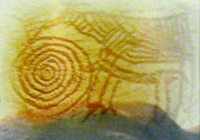happy winter solstice

Detail from Silent Messengers: Hoodoos II
Those of us in the northern Hemisphere can now breathe a collective sigh of relief that the sun has not disappeared forever and the days will be getting longer! Spring will come and we can begin planting again. I think of all the ancient cultures of the world that observed the solstices with festivals, rituals and great architecture to appease the spirits, long before Pope Julius tacked the celebration onto Saturnalia, the Roman winter festival, or jule became Christmas. It seems to me that we’ve lost some connection to nature’s rhythms and a universality of a common human celebration not based on a multitude of divisive religious doctrines.
I’ve been reading about winter solstice celebrations and architecture at Candlegrove where the well-known examples of Stonehenge and Newgrange, and Sun Dagger of Chaco Canyon, New Mexico, and even the medieval Catholic churches were all built as solar observatories. It would be very interesting to see a site devoted to all the world’s “solstice architecture” such as that of the Aztec and Mayan too, as I don’t have the time now to hunt for all the links. Anyone know of such a site?
Now I have to go bake the pistachio cranberry biscotti. Happy winter solstice to all!
Later: Thanks to The Megalithic Portal, I learned that BBC Radio 4 has a programme called A Light in Winter, in celebration of the Winter Solstice at Newgrange:
The winter solstice celebration at Newgrange monument, Ireland, is an awe-inspiring event that has taken place annually for more than 5000 years. As the sun’s rays clear the horizon on the shortest day of the year, they illuminate, in perfect alignment, a 19-metre passage and chamber which contains the remains of our long dead ancestors. The chamber is older than Stonehenge or the Pyramids and Trevor Barnes has gained rare access to the event to experience it for himself – joining the handful of people who are selected by lottery from more than 25,000 applicants.
December 21, 2005 in Culture, History by Marja-Leena